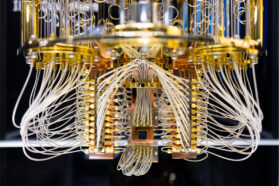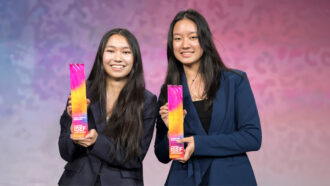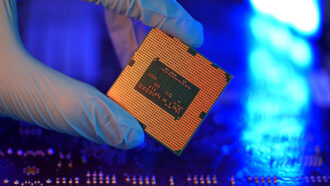Teen wins $100,000 for flu advance
Eric Chen claimed the top prize at the 2014 Intel Science Talent Search competition
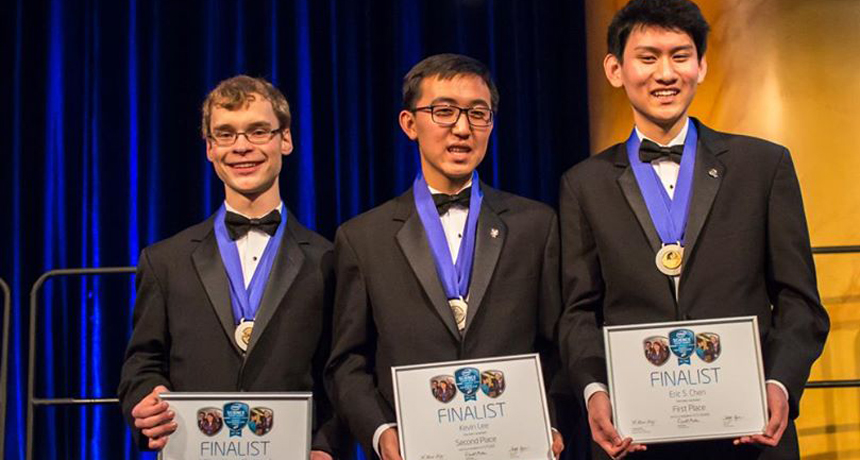
Top three champions in the 2014 Intel Science Talent Search competition. The 17-year-olds are, from left: William Kuszmaul, who came in third place; Kevin Lee, who placed second; and grand-prize winner Eric Chen (far right).
Patrick Thornton / SSP
By Sid Perkins
WASHINGTON — Following a weekend when most of the United States sprang forward to Daylight Savings Time, the nation’s top teen researchers sprang to the fore. The top 10 finishers in the 2014 Intel Science Talent Search all claimed big prizes. Their wins in the prestigious science competition were announced during a black-tie awards gala held here on Tuesday, March 11. The gala took place in the aptly named Great Hall of the National Building Museum.
Eric Chen, 17, of San Diego, Calif., earned the $100,000 grand prize for identifying new drug candidates for the treatment of influenza. A student at Canyon Crest Academy, he used supercomputers to analyze the chemical composition and shape of molecules that might interfere with an enzyme known as endonuclease. The flu virus depends on this enzyme to multiply. So if the new drugs work in people (something that has not yet been tested), they could slow or halt the infection’s spread. Chen’s research could lead to medicines that would counter a massive flu outbreak as new vaccines were being developed.
“I’m definitely surprised, I didn’t expect this at all,” Chen said of his first-place win. “All the other students are so amazing.”
Chen’s winning effort topped the research presented by 39 other Intel STS finalists, all high school seniors. The 40 were selected from nearly 1,800 entrants representing 45 states, the District of Columbia and seven overseas schools.
“Society for Science & the Public proudly joins Intel in congratulating Eric Chen for his impressive research toward potential new drugs for influenza,” says Rick Bates. He is interim CEO and chief advancement officer of SSP. “By linking technology and science to the problems of the world they see around them,” he observes, “Eric and all the Intel STS finalists are tomorrow’s problem solvers.”
Society for Science & the Public, publisher of Science News for Students, established the Science Talent Search competition in 1942. Intel began sponsoring the event in 1998. This year, Intel handed out awards to the 40 finalists totaling $630,000. Each teen returned home with at least $7,500.
Kevin Lee, 17, of Irvine, Calif., took second place in the competition, earning $75,000. A student at University High School, he developed a computer program that uses moving pictures of the heart to calculate the electrical signals that this organ produces. Besides running faster than previous computer models of heart action, the new program may one day provide insights into causes and potential treatments for serious irregular heartbeats. Doctors refer to these abnormal patterns as cardiac arrhythmias.
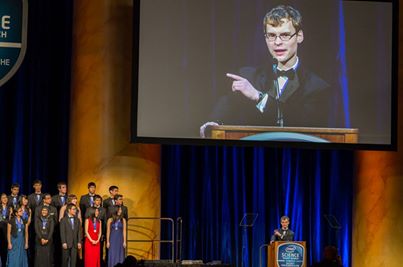
An 18-year-old from Teaneck, N.J., came in fourth place, and takes home $40,000. Joshua Abraham Meier attends the Academy for the Advancement of Science and Technology. His research probed how rapid changes in mitochondrial DNA (the genetic information in the tiny energy factories inside human cells) influence how certain types of stem cells age. This aging rate, in turn, limits the potential use of some stem cells in disease therapy. Meier identified a gene that prevents genetic defects from forming in the mitochondria. The finding may offer a novel approach to cancer therapy, among other applications.
Natalie Ng, 18, from Cupertino, Calif., collected fifth-place honors and an award of $30,000. The Monta Vista High School teen developed a statistical technique to help assess the spread, or metastasis, of breast cancer cells to other parts of the body. Her approach may one day guide long-term strategies for the treatment of cancer patients.
The competition’s next two winners each took home awards of $25,000. Aron Coraor, 17, of Huntington, N.Y., earned sixth place for his lab-based research. The Huntington High School student investigated how certain minerals formed long ago on the surface of the moon. Zarin Ibnat Rahman, 17, of Brookings High School in Brookings, S.D., studied teens’ use of smartphones, computers and other devices with electronic screens. She then looked at whether heavy use of these devices affected a student’s sleep patterns, mood, stress and academic performance.
The next three winners each won awards of $20,000.
Anand Srinivasan, 17, of Roswell High School in Roswell, Ga., took eighth place. His research identified gene boundaries in eukaryotes. These are plants, animals and other organisms whose cells have a nucleus. Srinivasan’s work could lead to better screening for diseases or to the tailoring of drugs to an individual’s genes.
John Anthony Clarke, 17, of Regis High School in Syosset, N.Y., grabbed ninth place for his computer program that simulates the behavior of particles in Jupiter’s magnetic field. His research suggests that a recently launched NASA satellite will indeed be able to observe the full gamut of X-ray emissions from the auroras — light displays — that take place high in the gas planet’s atmosphere.
Shaun Datta, 18, of North Potomac, Md., came in tenth place. The Montgomery Blair High School senior used a computer program to model the interactions between subatomic particles in neutron stars.
The other 30 finalists each received smaller cash prizes. All winners also received an all-expenses paid trip to Washington, D.C. On March 9, these teens presented their research to the public at the National Geographic Society. Just two days earlier, the finalists also briefly met with President Obama during a visit to the White House.
“We at Intel celebrate the work of these brilliant young scientists as a way to inspire the next generation to follow them with even greater energy and excitement into a life of invention and discovery,” said Wendy Hawkins. She’s executive director of the Santa Clara, Calif.-based Intel Foundation. “Imagine the new technologies, solutions and devices they will bring to bear on the challenges we face,” she says. “The Intel Science Talent Search finalists should inspire all of us with hope for the future.”
Power words
aurora A glow that results when large numbers of high-energy charged particles slam into the atmosphere, usually near a planet’s magnetic poles.
cancer Any of more than 100 different diseases, each characterized by the rapid, uncontrolled growth of abnormal cells. Their development and growth can lead to tumors, pain and death.
cardiac Relating to the heart.
cardiac arrhythmia Irregular heartbeat. There are several types of arrhythmias; the heart can beat too fast, too slow or in a pattern that’s not normal. Some arrhythmias are mild and have little if any effect, while others can be life-threatening.
computational biology A field in which scientists use mathematics and computer programs to better understand living things.
eukaryote Any organism whose cells have a nucleus. Eukaryotes include all multicellular creatures (such as plants, animals and fungi) as well as certain types of single-celled microorganisms.
gene A segment of DNA that codes, or holds instructions, for producing a protein. Offspring inherit genes from their parents. Genes influence how an organism looks and behaves.
genome The complete set of genes or genetic material in a cell or an organism.
influenza (orflu) A highly contagious viral infection of the respiratory passages causing fever and severe aching. It often occurs as an epidemic.
magnetic field An area of influence created by certain materials, called magnets, or by the movement of electric charges.
metastasis The spread of cancer from one organ or body part to another, either due to growth and invasion of neighboring tissues or the spread of individual cancer cells to remote areas through the bloodstream.
mineral The crystal-forming substances, such as quartz, apatite or various carbonates, that make up rock. Most rocks contain several different minerals mish-mashed together. A mineral usually is solid and stable at room temperatures and has a specific formula, or recipe (with atoms occurring in certain proportions) and a specific crystalline structure (meaning that its atoms are organized in certain regular three-dimensional patterns).
mitochondria (sing. mitochondrion) A structure in all cells (except bacteria) found outside of their nuclei. Here the cell breaks down nutrients and converts them into a form of energy known as ATP.
neutron star A small object with very high density. Astronomers believe neutron stars form when large stars undergo a supernova but aren’t big massive enough to form a black hole.
simulate To deceive in some way by imitating the form or function of something. A simulated dietary fat, for instance, may deceive the mouth that it has tasted a real fat because it has the same feel on the tongue — without having any calories. A simulated sense of touch may fool the brain into thinking a finger has touched something even though a hand may no longer exists and has been replaced by a synthetic limb. (in computing) To try and imitate the conditions, functions or appearance of something. Systems that do this are referred to as simulations.
subatomic Anything smaller than an atom, which is the smallest bit of matter that has all the properties of whatever chemical element it is (like hydrogen, iron or calcium).



